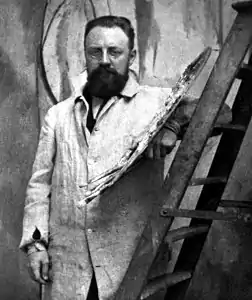1900s
The 1900s (pronounced "nineteen-hundreds") was a decade that began on January 1, 1900, and ended on December 31, 1909. The Edwardian era (1901–1910) covers a similar span of time. The term "nineteen-hundreds" is sometimes also used to mean the entire century from January 1, 1900 to December 31, 1999 (the years beginning with "19").

| Millennium |
|---|
| 2nd millennium |
| Centuries |
| Decades |
| Years |
| Categories |
|
The Scramble for Africa continued, with the Orange Free State, South African Republic, Ashanti Empire, Aro Confederacy, Sokoto Caliphate and Kano Emirate being conquered by the British Empire, alongside the French Empire conquering Borno, the German Empire conquering the Adamawa Emirate, and the Portuguese Empire conquering the Ovambo. Atrocities in the Congo Free State were committed by private companies and the Force Publique, with a resultant population decline[note 1] of 1 to 15 million. From 1904 to 1908, German colonial forces in South West Africa led a campaign of ethnic extermination and collective punishment, genociding 24,000 to 100,000 Hereros and 10,000 Namaqua. The First Moroccan and Bosnian crises led to worsened tensions in Europe that would ultimately lead to the First World War in the next decade. Cuba, Bulgaria, and Norway became independent.
The deadliest conventional war of this decade was the Russo-Japanese War, fought over rival imperial ambitions in Manchuria and the Korean Empire. Russia suffered a humiliating defeat in this conflict, contributing to a growing domestic unrest which culminated in the 1905 Russian Revolution. Unconventional wars of similar scale include insurrections in the Philippines (1899–1913), China (1899–1901), and Colombia (1899–1902). Lesser conflicts include interstate wars such as the Second Boer War (1899–1902), the Kuwaiti–Rashidi war (1900–1901), and the Saudi–Rashidi War (1903–1907), as well as failed uprisings and revolutions in Portuguese Angola (1902–1904), Rumelia (1903), Ottoman Eastern Anatolia (1904), Uruguay (1904), French Madagascar (1905–1906), Argentina (1905), Persia (1905–1911), German East Africa (1905–1907), and Romania (1907). A major famine took place in China from 1906 to 1907, possibly leading to 20–25 million deaths. This famine was directly caused by the 1906 China floods (April–October 1906), which hit the Huai River particularly hard and destroyed both the summer and autumn harvest. The 1908 Messina earthquake caused 75,000–82,000 deaths.
First-wave feminism saw progress, with universities being opened for women in Japan, Bulgaria, Cuba, Russia, and Peru. In 1906, Finland granted women the right to vote,[2] the first European country to do so.[3] The foundation of the Women's Social and Political Union by Emmeline Pankhurst in 1903 led to the rise of the Suffragettes in Great Britain and Ireland. In 1908, a revolution took place in the Ottoman Empire, where the Young Turks movement restored the Ottoman constitution of 1876, establishing the Second Constitutional Era. Subsequently, ethnic tensions rose, and in 1909, up to 30,000 mainly Armenian civilians in Adana were massacred by Muslim civilians.
The decade saw the widespread application of the internal combustion engine including mass production of the automobile, as well as the introduction of the typewriter. The Wright Flyer performed the first recorded controlled, powered, sustained heavier than air flight on 17 December 1903. Reginald Fessenden of East Bolton, Quebec, Canada made what appeared to be the first audio radio broadcasts of entertainment and music ever made to a general audience. The first huge success of American cinema, as well as the largest experimental achievement to this point, was the 1903 film The Great Train Robbery, directed by Edwin S. Porter, while the world's first feature film, The Story of the Kelly Gang, was released on 26 December 1906 in Melbourne, Australia. Popular books of this decade included The Tale of Peter Rabbit (1902) and Anne of Green Gables (1908), which sold 45 million and 50 million copies respectively. Popular songs of this decade include "Lift Every Voice and Sing" and "What Are They Doing in Heaven?", which have been featured in 42 and 16 hymnals respectively.
During the decade, the world population increased from 1.60 to 1.75 billion, with approximately 580 million births and 450 million deaths in total.
Pronunciation varieties
There are several main varieties of how individual years of the decade are pronounced. Using 1906 as an example, they are "nineteen-oh-six", "nineteen-six", and "nineteen-aught-six". Which variety is most prominent depends somewhat on global region and generation. "Nineteen-oh-six" is the most common; "nineteen-six" is less common. In American English, "nineteen-aught-six" is also recognized but not much used.
Demographics
Estimates for the world population by 1900 vary from 1.563 to 1.710 billion.
| PRB
(1973–2016)[4] |
UN
(2015)[5] |
Maddison
(2008)[6] |
HYDE
(2010)[7] |
Tanton
(1994)[8] |
Biraben
(1980)[9] |
McEvedy &
Jones (1978)[10] |
Thomlinson
(1975)[11] |
Durand
(1974)[12] |
Clark
(1967)[13] |
|---|---|---|---|---|---|---|---|---|---|
| 1,656M | 1,650M | 1,563M | 1,654M[14] | 1,600M | 1,633M | 1,625M | 1,600M | 1,650–1,710M | 1,668M |
Politics and wars

Major political changes
Wars
- Second Boer War ends.
- Philippine–American War takes place (1899–1902).
- The Kuwaiti–Rashidi war takes place (1900–1901).
- Russo-Japanese War establishes the Empire of Japan as a world power.
- Battle of Riyadh was a minor battle of the Unification of Saudi Arabia.
- Battle of Dilam was a major battle of the Unification War between Rashidi and Saudi rebels.
- First Saudi–Rashidi War was engaged between the Saudi loyal forces of the newborn Emirate of Riyadh versus the Emirate of Ha'il.
- The Ottomans invade Persia and capture a strip of territory (1906).
Internal conflicts
- The Boxer Rebellion ends.
- The Russian Revolution of 1905.
- The Mesopotamia uprising of 1906.
- Demand for Home Rule for Ireland.
- Herero and Namaqua Genocide in German South-West Africa (modern Namibia).
- Kurdish uprising in Bitlis against the Ottoman Empire in 1907.
Colonization
- 1 January 1901, British colonies in Australia federate, forming the Commonwealth of Australia.
Decolonization
- 20 May 1902 – Cuba gains independence from the United States
- 7 June 1905 – The Norwegian Parliament declares the union with Sweden dissolved, and Norway achieves full independence.
- 5 October 1908 – Bulgaria declares its independence from the Ottoman Empire.
Prominent political events
- 22 January 1901 the Death of Queen Victoria.
- 9 August 1902 The Coronation of Edward VII and Alexandra, as king and queen of the United Kingdom and the British Dominions.
Disasters
Natural disasters
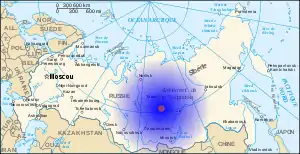
.jpg.webp)
- 8 September 1900 – A powerful hurricane hits Galveston, Texas, USA killing about 8,000.
- 19 April 1902 – A magnitude 7.5 earthquake rocks Guatemala, killing 2,000.
- 8 May 1902 – In Martinique, Mount Pelée erupts, destroying the town of Saint-Pierre and killing over 30,000.
- 7 April 1906 – Mount Vesuvius erupts and devastates Naples.
- 18 April 1906 – The 1906 San Francisco earthquake (estimated magnitude 7.8) on the San Andreas Fault destroys much of San Francisco, USA, killing at least 3,000, with 225,000–300,000 left homeless, and $350 million in damages.
- 18 September 1906 – A typhoon and tsunami kill an estimated 10,000 in Hong Kong.
- 14 January 1907 – An earthquake in Kingston, Jamaica kills more than 1,000.
- 30 June 1908 – The Tunguska event or "Russian explosion" near the Podkamennaya Tunguska River in Krasnoyarsk Krai, Siberia, Russian Empire occurs resulting in the flattening 2,000 km2 (770 sq mi) of forest. It is believed to have been caused by the air burst of a large meteoroid or comet fragment, at an altitude of 5–10 kilometres (3–6 mi) above the Earth's surface.[15][16][17]
- 28 December 1908 – An earthquake and tsunami destroys Messina, Sicily and Calabria, killing over 80,000 people.
Non-natural disasters
- 26 April 1900 – The Great Lumber Fire of Ottawa–Hull kills 7 and leaves 15,000 homeless.
- 1 May 1900 – The Scofield Mine disaster in Scofield, Utah caused by explosion killing at least 200 men.
- 30 June 1900 – Hoboken Docks Fire: The German passenger ships Saale, Main, Bremen, and Kaiser William der Grosse, all owned by the North German Lloyd Steamship line, catch fire at the docks in Hoboken, New Jersey, USA . The fire began on a wharf and spread to the adjacent piers, warehouses, and smaller craft, killing 326 people.
- 3 May 1901 – The Great Fire of 1901 begins in Jacksonville, FL, USA .
- 10 July 1902 – The Rolling Mill Mine disaster in Johnstown, Pennsylvania, USA, kills 112 miners.
- 10 August 1903 – Paris Métro train fire.
- 30 December 1903 – A fire at the Iroquois Theater in Chicago, USA kills 600.
- 7 February 1904 – The Great Baltimore Fire in Baltimore, USA destroys over 1,500 buildings in 30 hours.
- 15 June 1904 – A fire aboard the steamboat General Slocum in New York City's East River kills 1,021.
- 28 June 1904 – The Danish ocean liner SS Norge runs aground and sinks close to Rockall, killing 635, including 225 Norwegian emigrants.
- 22 January 1906 – The SS Valencia strikes a reef off Vancouver Island, Canada, killing over 100 (officially 136) in the ensuing disaster.
Assassinations and attempts
Prominent assassinations, targeted killings, and assassination attempts include:

| Year | Date | Name | Position | Country | Description |
|---|---|---|---|---|---|
| 1900 | 29 July | Umberto I | King | Italy | Assassinated by anarchist Gaetano Bresci. |
| 1901 | 6 March | Wilhelm II | Kaiser | Germany | Attempted assassination in Bremen by Deidrich Weiland.[18][19] |
| 1901 | 6 September | William McKinley | President | United States | Dies 8 days after being shot at the Pan-American Exposition in Buffalo, New York, by American anarchist Leon Czolgosz. |
| 1904 | 16 June | Nikolai Bobrikov | Governor-General | Finland | Assassinated by nationalist nobleman Eugen Schauman. |
| 1905 | 13 June | Theodoros Diligiannis | Prime Minister | Greece | Killed by gambler Antonios Gherakaris, reportedly for measures taken against gambling places. |
| 1907 | 11 March | Dimitar Petkov | Prime Minister | Bulgaria | Killed by an anarchist. |
| 1907 | 31 August | Amin al-Soltan | Prime Minister | Iran | Killed in front of the Parliament. |
| 1908 | 1 February | Carlos I | King | Portugal | Assassinated in Lisbon, Portugal. |
| 1909 | 26 October | Itō Hirobumi | Prime Minister | Japan | Also Resident-General of Korea, assassinated by Ahn Jung-geun at the Harbin train station in Manchuria, for many grievances against Japan, including the assassination of Empress Myeongseong of Korea. |
Economics
The cost of an American postage stamp was worth 1 cent.[20]
Science and technology
Science
.jpg.webp)
- 17 March 1905 – Annus Mirabilis papers – Albert Einstein publishes his paper "On a heuristic viewpoint concerning the production and transformation of light", in which he explains the photoelectric effect, using the notion of light quanta. For this paper Einstein received the Nobel Prize for Physics in 1921.
- 11 May 1905 – Annus Mirabilis papers – Albert Einstein submits his doctoral dissertation "On the Motion of Small Particles...", in which he explains Brownian motion.
- 30 June 1905 – Annus Mirabilis papers – Albert Einstein publishes the article "On the Electrodynamics of Moving Bodies", where he reveals his theory of special relativity.
- 27 September 1905 – Annus Mirabilis papers – Albert Einstein submits his paper "Does the Inertia of a Body Depend Upon Its Energy Content?", in which he develops an argument for the famous equation E = mc2.
- Planck's law of black-body radiation
- Seismographs built in the University of California, Berkeley, in 1900
- Practical air conditioner designed by Willis Carrier in 1902
- Geiger counter (measures radioactivity) invented by Hans Geiger in 1908
- Pierre and Marie Curie discover radium and polonium, they coin the term 'radioactivity'.
- Third law of thermodynamics by Walther Nernst
- Quantum Hypothesis by Max Planck in 1900[21][22][23][24][25]
- The Bacillus Calmette-Guérin (BCG) immunization for tuberculosis is first developed.
Technology
- Widespread application of the internal combustion engine including mass production of the automobile. Rudolf Diesel demonstrated the diesel engine in the 1900 Exposition Universelle (World's Fair) in Paris using peanut oil fuel (see biodiesel). The Diesel engine takes the Grand Prix. The exposition was attended by 50 million people.[26] The same year Wilhelm Maybach designed an engine built at Daimler Motoren Gesellschaft—following the specifications of Emil Jellinek—who required the engine to be named Daimler-Mercedes after his daughter, Mercédès Jellinek. In 1902, the Mercedes 35 hp automobiles with that engine were put into production by DMG.[27]
- Wide popularity of home phonograph. "The market for home machines was created through technological innovation and pricing: Phonographs, gramophones, and graphophones were cleverly adapted to run by spring-motors (you wound them up), rather than by messy batteries or treadle mechanisms, while the musical records were adapted to reproduce loudly through a horn attachment. The cheap home machines sold as the $10 Eagle graphophone and the $40 (later $30) Home phonograph in 1896, the $20 Zon-o-phone in 1898, the $3 Victor Toy in 1900, and so on. Records sold because their fidelity improved, mass production processes were soon developed, advertising worked, and prices dropped from one and two dollars to around 35 cents.".[28][29] In 1907, a Victor Records recording of Enrico Caruso singing Ruggero Leoncavallo's "Vesti la giubba" becomes the first to sell a million copies.[30]
- 1899–1900 – Thomas Alva Edison of Milan, Ohio, invents the nickel-alkaline storage battery. On 27 May 1901, Edison establishes the Edison Storage Battery Company to develop and manufacture them.[31] "It proved to be Edison's most difficult project, taking ten years to develop a practical alkaline battery. By the time Edison introduced his new alkaline battery, the gasoline powered car had so improved that electric vehicles were becoming increasingly less common, being used mainly as delivery vehicles in cities. However, the Edison alkaline battery proved useful for lighting railway cars and signals, maritime buoys, and miners lamps. Unlike iron ore mining with the Edison Ore-Milling Company, the heavy investment Edison made over ten years was repaid handsomely, and the storage battery eventually became Edison's most profitable product. Further, Edison's work paved the way for the modern alkaline battery."[32]
- 1900 – The Brownie camera is invented; this was the beginning of the Eastman Kodak company. The Brownie popularized low-cost photography and introduced the concept of the snapshot. The first Brownie was introduced in February 1900,[33]
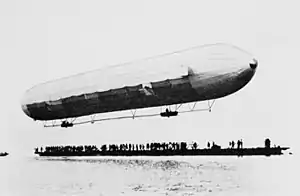
- 1900 – The first zeppelin flight occurs over Lake Constance near Friedrichshafen, Germany on 2 July 1900.

- 1901 – First electric typewriter is invented by George Canfield Blickensderfer of Erie, Pennsylvania. It was part of a line of Blickensderfer typewriters, known for its portability.[34][35][36]
- 1901 – Wilhelm Kress of Saint Petersburg, Russia creates his Kress Drachenflieger in Austria-Hungary. Power was provided by a Daimler petrol engine driving two large auger-style two-bladed propellers, the first attempt to use an internal combustion engine to power a heavier-than-air aircraft.[37][38]
- 1901 – The first radio receiver (successfully received a radio transmission). This receiver was developed by Guglielmo Marconi. Marconi established a wireless transmitting station at Marconi House, Rosslare Strand, County Wexford, Ireland in 1901 to act as a link between Poldhu in Cornwall and Clifden in County Galway. He soon made the announcement that on 12 December 1901, using a 152.4-meter (500 ft) kite-supported antenna for reception, the message was received at Signal Hill in St John's, Newfoundland (now part of Canada), signals transmitted by the company's new high-power station at Poldhu, Cornwall. The distance between the two points was about 3,500 kilometers (2,200 mi). Heralded as a great scientific advance, there was—and continues to be—some skepticism about this claim, partly because the signals had been heard faintly and sporadically. There was no independent confirmation of the reported reception, and the transmissions, consisting of the Morse code letter S sent repeatedly, were difficult to distinguish from atmospheric noise. (A detailed technical review of Marconi's early transatlantic work appears in John S. Belrose's work of 1995.)[39] The Poldhu transmitter was a two-stage circuit.[40][41] The first stage operated at a lower voltage and provided the energy for the second stage to spark at a higher voltage.
- 1902 – Willis Carrier of Angola, New York, invented the first indoor air conditioning. "He designed his spray driven air conditioning system which controlled both temperature and humidity using a nozzle originally designed to spray insecticide. He built his "Apparatus for Treating Air" (U.S. Pat. #808897) which was patented in 1906 and using chilled coils which not only controlled heat but could lower the humidity to as low as 55%. The device was even able to adjust the humidity level to the desired setting creating what would become the framework for the modern air conditioner. By adjusting the air movement and temperature level to the refrigeration coils he was able to determine the size and capacity of the unit to match the need of his customers. While Carrier was not the first to design a system like this his was much more stable, successful and safer than other versions and took air conditioning out of the Dark Ages and into the realm of science."[42]
- 1902/1906/1908 – Sir James Mackenzie of Scone, Scotland invented an early lie detector or polygraph. MacKenzie's polygraph "could be used to monitor the cardiovascular responses of his patients by taking their pulse and blood pressure.[43] He had developed an early version of his device in the 1890s, but had Sebastian Shaw, a Lancashire watchmaker, improve it further. "This instrument used a clockwork mechanism for the paper-rolling and time-marker movements and it produced ink recordings of physiological functions that were easier to acquire and to interpret. It has been written that the modern polygraph is really a modification of Dr. Mackenzie's clinical ink polygraph."[44] A more modern and effective polygraph machine would be invented by John Larson in 1921.[45]
- 1902 – Georges Claude invented the neon lamp. He applied an electrical discharge to a sealed tube of neon gas, resulting in a red glow. Claudes started working on neon tubes which could be put to use as ordinary light bulbs. His first public display of a neon lamp took place on 11 December 1910, in Paris.[46] In 1912, Claude's associate began selling neon discharge tubes as advertising signs. They were introduced to U.S. in 1923 when two large neon signs were bought by a Los Angeles Packard car dealership. The glow and arresting red color made neon advertising completely different from the competition.[47]
- 1902 – Teasmade, a device for making tea automatically, is patented on 7 April 1902 by gunsmith Frank Clarke of Birmingham, England. He called it "An Apparatus Whereby a Cup of Tea or Coffee is Automatically Made" and it was later marketed as "A Clock That Makes Tea!". However, his original machine and all rights to it had been purchased from its actual inventor Albert E. Richardson, a clockmaker from Ashton-under-Lyne. The device was commercially available by 1904.[48]
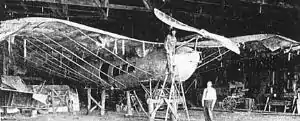
- 1902 – Lyman Gilmore of Washington, United States is awarded a patent for a steam engine, intended for use in aerial vehicles. At the time he was living in Red Bluff, California. At a later date, Gilmore claimed to have incorporated his engine in "a monoplane with a 32 foot wingspan" and to have performed his debut flight in May 1902. While occasionally credited with the first powered flight in aviation history, there is no supporting evidence for his account.[49] While Gilmore was probably working on aeronautical experiments since the late 1890s and reportedly had correspondence with Samuel Pierpont Langley, there exists no photo of his creations earlier than 1908.[50]
- 1902 – The Wright brothers of Ohio, United States create the 1902 version of the Wright Glider. It was the third free-flight glider built by them and tested at Kitty Hawk, North Carolina. This was the first of the brothers' gliders to incorporate yaw control, and its design led directly to the 1903 Wright Flyer. The brothers designed the 1902 glider during the winter of 1901–1902 at their home in Dayton, Ohio. They designed the wing based on data from extensive airfoil tests conducted on a homemade wind tunnel. They built many of the components of the glider in Dayton, but they completed assembly at their Kitty Hawk camp in September 1902. They began testing on 19 September. Over the next five weeks, they made between 700 and 1000 glide flights (as estimated by the brothers, who did not keep detailed records of these tests). The longest of these was 622.5 ft (189.7 m) in 26 seconds. "In its final form, the 1902 Wright glider was the world's first fully controllable aircraft."[51][52]
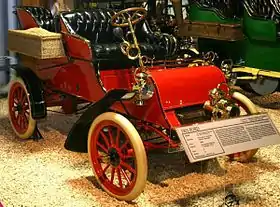
- 1903 – Ford Motor Company produces its first car – the Ford Model A.
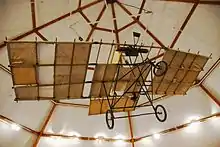
- 1903 – Richard Pearse of New Zealand supposedly successfully flew and landed a powered heavier-than-air machine on 31 March 1903[53] Verifiable eyewitnesses describe Pearse crashing into a hedge on two separate occasions during 1903. His monoplane must have risen to a height of at least three metres on each occasion. Good evidence exists that on 31 March 1903 Pearse achieved a powered, though poorly controlled, flight of several hundred metres. Pearse himself said that he had made a powered takeoff, "but at too low a speed for [his] controls to work". However, he remained airborne until he crashed into the hedge at the end of the field.[54][55]
- 1903 – Karl Jatho of Germany performs a series of flights at Vahrenwalder Heide, near Hanover, between August and November, 1903. Using first a pusher triplane, then a biplane. "His longest flight, however, was only 60 meters at 3–4 meters altitude." He then quit his efforts, noting his motor was too weak to make longer or higher flights.[56] The plane was equipped with a single-cylinder 10 horsepower (7.5 kW) Buchet engine driving a two-bladed pusher propeller and made hops of up to 200 ft (60 m), flying up to 10 ft (3 m) high. In comparison, Orville Wright's first controlled flight four months later was of 36 m (120 ft) in 12 seconds although Wilbur flew 59 seconds and 852 ft (260 m) later that same day. Either way Jatho managed to fly a powered heavier-than-air machine earlier than his American counterparts.[57]
- 1903 – Mary Anderson invented windshield wipers. In November 1903 Anderson was granted her first patent[58] for an automatic car window cleaning device controlled inside the car, called the windshield wiper.[59] Her device consisted of a lever and a swinging arm with a rubber blade. The lever could be operated from inside a vehicle to cause the spring-loaded arm to move back and forth across the windshield. Similar devices had been made earlier, but Anderson's was the first to be effective.[60]

- 1903 – The Wright brothers fly at Kitty Hawk, North Carolina. Their airplane, the Wright Flyer, performed the first recorded controlled, powered, sustained heavier than air flight on 17 December 1903. In the day's fourth flight, Wilbur Wright flew 279 meters (852 ft) in 59 seconds. First three flights were approximately 120, 175, and 200 ft (61 m), respectively. The Wrights laid particular stress on fully and accurately describing all the requirements for controlled, powered flight and put them into use in an aircraft which took off from a level launching rail, with the aid of a headwind to achieve sufficient airspeed before reaching the end of the rail.[61] It is one of the various candidates regarded as the First flying machine.
- 1904 – SS Haimun sends its first news story on 15 March 1904.[62] It was a Chinese steamer ship commanded by war correspondent Lionel James in 1904 during the Russo-Japanese War for The Times. It is the first known instance of a "press boat" dedicated to war correspondence during naval battles. The recent advent of wireless telegraphy meant that reporters were no longer limited to submitting their stories from land-based offices, and The Times spent 74 days outfitting and equipping the ship,[63] installing a De Forest transmitter aboard the ship.[64]
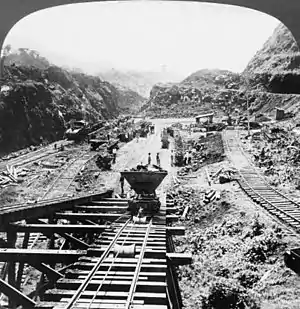
- 1904–1914 – The Panama Canal constructed by the United States in the territory of Panama, which had just gained independence from Colombia. The Canal is a 77 km (48 mi) ship canal that joins the Atlantic Ocean and the Pacific Ocean and a key conduit for international maritime trade. One of the largest and most difficult engineering projects ever undertaken, the canal had an enormous impact on shipping between the two oceans, replacing the long and treacherous route via the Drake Passage and Cape Horn at the southernmost tip of South America. A ship sailing from New York to San Francisco via the canal travels 9,500 km (5,900 mi), well under half the 22,500 km (14,000 mi) route around Cape Horn.[65] The project starts on 4 May 1904, known as Acquisition Day. The United States government purchased all Canal properties on the Isthmus of Panama from the New Panama Canal Company, except the Panama Railroad.[66] The project begun under the administration of Theodore Roosevelt, continued in that of William Howard Taft and completed in that of Woodrow Wilson.[67][68] The Chief engineers were John Frank Stevens and George Washington Goethals[69][70]
- 1904 – The Welte-Mignon reproducing piano is created by Edwin Welte and Karl Bockisch. Both employed by the "Michael Welte und Söhne" firm of Freiburg im Breisgau, Germany. "It automatically replayed the tempo, phrasing, dynamics and pedalling of a particular performance, and not just the notes of the music, as was the case with other player pianos of the time." In September, 1904, the Mignon was demonstrated in the Leipzig Trade Fair. In March, 1905 it became better known when showcased "at the showrooms of Hugo Popper, a manufacturer of roll-operated orchestrions". By 1906, the Mignon was also exported to the United States, installed to pianos by the firms Feurich and Steinway & Sons.[71]
- 1904 – Benjamin Holt of the Holt Manufacturing Company invents one of the first practical continuous tracks for use in tractors. While the date of invention was reportedly 24 November 1904, Holt would not receive a patent until December, 1907.[72]
- 1905 – John Joseph Montgomery of California, United States designs tandem-wing gliders. His pilot Daniel Maloney performs a number of public exhibitions of high altitude flights in March and April 1905 in the Santa Clara, California, area. These flights received national media attention and demonstrated superior control of the design, with launches as high as 4,000 feet (1,200 m) and landings made at predetermined locations. The gliders were launched from balloons.[73][74]
- 1905 – The Wright Brothers introduce their Wright Flyer III. On 5 October 1905, Wilbur flew 24 miles (39 km) in 39 minutes 23 seconds,[75] longer than the total duration of all the flights of 1903 and 1904. Ending with a safe landing when the fuel ran out. The flight was seen by a number of people, including several invited friends, their father Milton, and neighboring farmers.[76] Four days later, they wrote to the United States Secretary of War William Howard Taft, offering to sell the world's first practical fixed-wing aircraft.
- 1906 – The Gabel Automatic Entertainer, an early jukebox-like machine, is invented by John Gabel. It is the first such device to play a series of gramophone records. "The Automatic Entertainer with 24 selections, was produced and patented by the John Gabel owned company in Chicago. The first model (constructed in 1905) was produced in 1906 with an exposed 40 inch horn (102 cm) on top, and it is today often considered the real father of the modern multi-selection disc-playing phonographs. John Gabel and his company did in fact receive a special prize at the Pan-Pacific Exposition for the Automatic Entertainer."[77][78]

- 1906 – The Victor Talking Machine Company releases the Victrola, the most popular gramophone model until the late 1920s.[79] The Victrola is also the first playback machine containing an internal horn.[80] Victor also erects the world's largest illuminated billboard at the time, on Broadway in New York City, to advertise the company's records.[81]
- 1906 – Traian Vuia of Romania takes off with his "Traian Vuia 1", an early monoplane. His flight was performed in Montesson near Paris and was about 12 meters long.[82]
- 1906 – Jacob Ellehammer of Denmark constructs the Ellehammer semi-biplane. In this machine, he made a tethered flight on 12 September 1906, becoming the second European to make a powered flight.[83][84][85]
- 1906 – Alberto Santos-Dumont and his Santos-Dumont 14-bis make the first public flight of an airplane on 23 October 1906, in Paris. The flying machine was the first fixed-wing aircraft officially witnessed to take off, fly, and land. Santos Dumont is considered the "Father of Aviation" in his country of birth, Brazil.[86] His flight is the first to have been certified by the Aéro-Club de France and the Fédération Aéronautique Internationale (FAI).[87][88] On 12 November 1906, Santos Dumont succeeded in setting the first world record recognized by the Aero-Club De France by flying 220 metres in less than 22 seconds.[89]
- 1906 – Sound radio broadcasting was invented by Reginald Fessenden and Lee De Forest. Fessenden and Ernst Alexanderson developed a high-frequency alternator-transmitters, an improvement on an already existing device. The improved model operated at a transmitting frequency of approximately 50 kHz, although with far less power than Fessenden's rotary-spark transmitters. The alternator-transmitter achieved the goal of transmitting quality audio signals, but the lack of any way to amplify the signals meant they were somewhat weak. On 21 December 1906, Fessenden made an extensive demonstration of the new alternator-transmitter at Brant Rock, showing its utility for point-to-point wireless telephony, including interconnecting his stations to the wire telephone network. A detailed review of this demonstration appeared in The American Telephone Journal.[90] Meanwhile, De Forest had developed the Audion tube an electronic amplifier device. He received a patent in January 1907.[91] "DeForest's audion vacuum tube was the key component of all radio, telephone, radar, television, and computer systems before the invention of the transistor in 1947."[92]
- 1906 – Reginald Fessenden of East Bolton, Quebec, Canada made what appear to be the first audio radio broadcasts of entertainment and music ever made to a general audience. (Beginning in 1904, the United States Navy had broadcast daily time signals and weather reports, but these employed spark-gap transmitters, transmitting in Morse code). On the evening of December 24, 1906 (Christmas Eve), Fessenden used the alternator-transmitter to send out a short program from Brant Rock, Plymouth County, Massachusetts. It included a phonograph record of Ombra mai fù (Largo) by George Frideric Handel, followed by Fessenden himself playing the song O Holy Night on the violin. Finishing with reading a passage from the Bible: 'Glory to God in the highest and on earth peace to men of good will' (Gospel of Luke 2:14). On 31 December, New Year's Eve, a second short program was broadcast. The main audience for both these transmissions was an unknown number of shipboard radio operators along the East Coast of the United States. Fessenden claimed that the Christmas Eve broadcast had been heard "as far down" as Norfolk, Virginia, while the New Year Eve's broadcast had reached places in the Caribbean. Although now seen as a landmark, these two broadcasts were barely noticed at the time and soon forgotten— the only first-hand account appears to be a letter Fessenden wrote on 29 January 1932, to his former associate, Samuel M. Kinter.[93][94]

- 1907 – The Autochrome Lumière which was patented in 1903 becomes the first commercial color photography process.
- 1907 – Thomas Edison invented the "Universal Electric Motor" which made it possible to operate dictation machines, etc. on all lighting circuits.[95]
- 1907 – The Photostat machine begins the modern era of document imaging. The Photostat machine was invented in Kansas City, Kansas, United States by Oscar Gregory in 1907, and the Photostat Corporation was incorporated in Rhode Island in 1911. "Rectigraph and Photostat machines (Plates 40–42) combined a large camera and a developing machine and used sensitized paper furnished in 350-foot rolls. "The prints are made direct on sensitized paper, no negative, plate or film intervening. The usual exposure is ten seconds. After the exposure has been made the paper is cut off and carried underneath the exposure chamber to the developing bath, where it remains for 35 seconds, and is then drawn into a fixing bath. While one print is being developed or fixed, another exposure can be made. When the copies are removed from the fixing bath, they are allowed to dry by exposure to the air, or may be run through a drying machine. The first print taken from the original is a 'black' print; the whites in the original are black and the blacks, white. (Plate 43) A white 'positive' print of the original is made by rephotographing the black print. As many positives as required may be made by continuing to photograph the black print." (The American Digest of Business Machines, 1924.) Du Pont Co. files include black prints of graphs dating from 1909, and the company acquired a Photostat machine in 1912. ... A 1914 Rectigraph ad stated that the U.S. government had been using Rectigraphs for four years and stated that the machines were being used by insurance companies and abstract and title companies. ... In 1911, a Photostat machine was $500."[96][97]

- 1908 – Henry Ford of the Ford Motor Company introduces the Ford Model T. The first production Model T was built on 27 September 1908, at the Ford Piquette Avenue Plant in Detroit. It is generally regarded as the first affordable automobile, the car that "put America on wheels"; some of this was because of Ford's innovations, including assembly line production instead of individual hand crafting, as well as the concept of paying the workers a wage proportionate to the cost of the car, so that they would provide a ready made market.[98]
- 1909 – Leo Baekeland of Sint-Martens-Latem, Belgium officially announces his creation of Bakelite. The announcement was made at the February 1909 meeting of the New York section of the American Chemical Society.[99] Bakelite is an inexpensive, nonflammable, versatile, and popular plastic.[100][101][102]
Popular culture
Literature
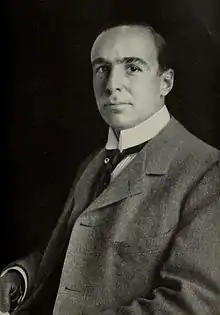
The best selling books of the decade were Anne of Green Gables (1908) and The Tale of Peter Rabbit (1902), which sold 50 million[103] and 45 million[104] copies respectively. Serbian writers used the Belgrade literary style, an Ekavian writing form which set basis for the later standardization of the Serbian language. Theodor Herzl, the founder of political Zionism, published The Old New Land in 1902, outlining Herzl's vision for a Jewish state in the Land of Israel.
Below are the best-selling books in the United States of each year, as determined by Publishers Weekly.[105]
- 1900: To Have and to Hold by Mary Johnston
- 1901: The Crisis by Winston Churchill
- 1902: The Virginian by Owen Wister
- 1903: Lady Rose's Daughter by Mary Augusta Ward
- 1904: The Crossing by Winston Churchill
- 1905: The Marriage of William Ashe by Mary Augusta Ward
- 1906: Coniston by Winston Churchill
- 1907: The Lady of the Decoration by Frances Little
- 1908: Mr. Crewe's Career by Winston Churchill
- 1909: The Inner Shrine by Anonymous (Basil King)
Art
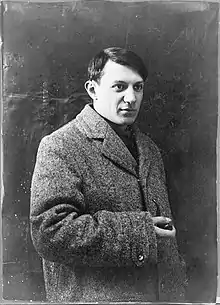
- Pablo Picasso paints Les Demoiselles d'Avignon, considered by some to be the birth of modern art.
- Art Nouveau art movement peaked in popularity at the turn of the 20th century (1890–1905).
- Cubism art movement peaked in popularity in France between 1907 and 1911.
- Fauvism art movement peaked in popularity between 1905 and 1907.
Film

- 2 April 1902 – Electric Theatre, the first movie theater in the United States, opens in Los Angeles.
- The first huge success of American cinema, as well as the largest experimental achievement to this point, was the 1903 film The Great Train Robbery, directed by Edwin S. Porter.
- The world's first feature film, The Story of the Kelly Gang is released on 26 December 1906 in Melbourne, Australia.
Music
Popular songs of the 1900s include "Lift Every Voice and Sing" and "What Are They Doing in Heaven?", which have been featured in 42[106] and 16[107][108] hymnals respectively.
- 23 January 1900 – The Pittsburgh Symphony Orchestra makes its Carnegie Hall debut with Victor Herbert conducting.
- 3 February 1900 – Adonais, overture by George Whitefield Chadwick is premiered by the Boston Symphony Orchestra.
- 15 December 1900 – The second and third movements of Concerto No.2 in C Minor for Piano by Sergej Rachmaninov receive their world premiere in Moscow, with Rachmaninov playing the solo part.
- 29 March 1901 – Jean de Reszke's final performance of the season with the Metropolitan Opera turns into his farewell performance with that company as he sings the title role in Wagner's Lohengrin.
- 27 October 1901 – Claude Debussy's Trois Nocturnes is given in its first complete performance as Camille Chevillard conducts the Lamoureux Orchestra in Paris.
- 9 November 1901 – First complete performance of Sergei Rachmaninoff's Piano Concerto no. 2 in C Minor in Moscow with Rachmaninoff playing the solo part.
- 16 December 1902 – Scott Joplin's signature rag, "The Entertainer", is released.
- October 18, 1904 – Gustav Mahler's Symphony No. 5 is premiered by the Gürzenich Orchestra Cologne with Mahler conducting.
- 1905 - Claude Debussy releases his masterpiece and signature song, "Clair de Lune".
- 27 January 1907 – Executives of the Metropolitan Opera removes Richard Strauss's Salome from the repertoire following protests that the opera was indecent.
- 26 January 1908 – Sergei Rachmaninoff's Symphony No. 2 receives its première.
- 15 March 1908 – Maurice Ravel's Rapsodie espagnole receives its première in Paris.
- 11 April 1908 – Spyridon Samaras's opera Rhea is premiered in Florence (Teatro Verdi)
- 19 September 1908 – Première of Gustav Mahler's Symphony No. 7 in Prague.
- 25 January 1909 – Richard Strauss's opera Elektra receives its debut performance at the Dresden State Opera
- 19 February 1909 – First production Bedřich Smetana's opera Prodaná nevěsta (The Bartered Bride) in the USA v Metropolitan Opera, conducted by Gustav Mahler with Ema Destinová in the titul role.
- 22 February 1909 – Thomas Beecham conducts the first concert with his newly established Beecham Symphony Orchestra in the UK.
- 8 November 1909 – Boston Opera House in the United States opens with a performance of La Gioconda starring Lillian Nordica and Louise Homer.
- 28 November 1909 – Sergei Rachmaninoff's Piano Concerto No. 3 is premièred in New York City.
- 18 December 1909 – George Enescu's Octet for Strings and Piano Quartet No. 1 in D Major are premiered together on a program also featuring his Sept chansons de Clement Marot, Op. 15, at the Salle des agriculteurs in Paris, as part of the "Soirées d'Art" concert series.
Fashion
Historic events
Agustín Lizárraga discovers Machu Picchu on 14 July 1902.
Sports
The Tour de France starts for the first time in 1903.[109]
Food
- U.S. New Haven, Connecticut Louis Lassen of Louis' Lunch makes the first modern-day hamburger sandwich. According to family legend, one day in 1900 a local businessman dashed into the small New Haven lunch wagon and pleaded for a lunch to go. According to the Lassen family, the customer, Gary Widmore, exclaimed "Louie! I'm in a rush, slap a meatpuck between two planks and step on it!".[110][111] Louis Lassen, the establishment's owner, placed his own blend of ground steak trimmings between two slices of toast and sent the gentleman on his way, so the story goes, with America's alleged first hamburger being served.[112]
People
Modern artists
- Umberto Boccioni
- Pierre Bonnard
- Georges Braque
- Paul Cézanne
- Marc Chagall
- Edgar Degas
- André Derain
- Raoul Dufy
- Paul Gauguin
- Juan Gris
- Wassily Kandinsky
- Gustav Klimt
- Fernand Léger
- Kazimir Malevich
- Henri Matisse
- Amedeo Modigliani
- Claude Monet
- Pablo Picasso
- Pierre-Auguste Renoir
- Auguste Rodin
- Georges Rouault
- Henri Rousseau
- Albert Pinkham Ryder
- Egon Schiele
- Gino Severini
- Paul Signac
- Henri Toulouse-Lautrec
- Suzanne Valadon
- Maurice de Vlaminck
- Gustave Caillebotte
- Édouard Manet
- Camille Pissarro
- Georges Seurat
- Alfred Sisley
Other notable people
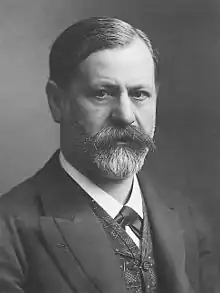
- Agustín Lizárraga
- Eugen d'Albert
- Hugo Alfvén
- Egbert Van Alstyne
- Broncho Billy Anderson
- Fatty Arbuckle
- Louis Daniel Armstrong
- Kurt Atterberg
- Béla Bartók
- Nora Bayes
- Jagdish Chandra Bose
- Irving Berlin
- Francis Boggs
- Frank Bridge
- Alfred Bryan
- Vincent P. Bryan
- Ferruccio Busoni
- Enrico Caruso
- Gustave Charpentier
- Thurland Chattaway
- Francesco Cilea
- Will D. Cobb
- Bob Cole
- Frederick Converse
- Henry Creamer
- Henry Walford Davies
- Peter Dawson
- Claude Debussy
- Frederick Delius
- Paul Dresser
- Antonín Dvořák
- Gus Edwards
- Edward Elgar
- August Enna
- Manuel de Falla
- Geraldine Farrar
- Fred Fisher
- Paul Le Flem
- Sigmund Freud
- Rudolf Friml
- Julius Fučík
- Amelita Galli-Curci
- Mary Garden
- Edward German
- Alexander Glazunov
- Emilio de Gogorza
- Percy Grainger
- Enrique Granados
- D. W. Griffith
- Guy d'Hardelot
- Hamilton Harty
- The Haydn Quartet
- Anna Held
- Victor Herbert
- Max Hoffmann
- Gustav Holst
- Abe Holzmann
- David Horsley
- Harry Houdini
- Mississippi John Hurt
- Jenö Huszka
- Mikhail Ippolitov-Ivanov
- Carrie Jacobs-Bond
- Alfred Jarry
- William Jerome
- J. Rosamond Johnson
- James Weldon Johnson
- Scott Joplin
- Gus Kahn
- Jerome Kern
- Rudyard Kipling
- Carl Laemmle
- Harry Lauder
- Lead Belly
- Franz Lehár
- Ruggiero Leoncavallo
- Paul Lincke
- Gustav Mahler
- Arthur Marshall
- Jules Massenet
- Nikolai Karlovich Medtner
- Nellie Melba
- Georges Méliès
- Kerry Mills
- Billy Murray
- Evelyn Nesbit
- Ethelbert Woodbridge Nevin
- Carl Nielsen
- Jack Norworth
- Vítězslav Novák
- Maude Nugent
- Sidney Olcott
- Charles Pathé
- Edwin S. Porter
- Giacomo Puccini
- Sergei Rachmaninoff
- Maurice Ravel
- Ottorino Respighi
- Nikolai Rimsky-Korsakov
- Landon Ronald
- Paul Sarebresole
- Erik Satie
- Arnold Schoenberg
- Jean Schwartz
- James Scott
- Alexander Scriabin
- William Selig
- Chris Smith
- Harry B. Smith
- Ethel Smyth
- John Philip Sousa
- George Kirke Spoor
- Charles Villiers Stanford
- Andrew B. Sterling
- Oscar Strauss
- Harry Von Tilzer
- Tom Turpin
- Edgard Varèse
- Vesta Victoria
- Anton Webern
- Percy Wenrich
- Bert Williams
- Harry Williams
- Ermanno Wolf-Ferrari
- Amy Woodforde-Finden
- Israel Zangwill
- Ferdinand von Zeppelin
- Charles A. Zimmerman
Sports figures
Baseball |
Boxing
|
Cricket |
Last survivors
Born on 27 May 1909, Venezuelan Juan Vicente Pérez is currently the last man alive verified to have been born in the decade.[113][114] The currently oldest person in the world is American-born Spaniard Maria Branyas who was born on 4 March 1907.
See also
Further reading
- Hale, Williams Bayard (January 1911). "A Dramatic Decade of History: What The First Ten Years Of The Twentieth Century Witnessed Of International Stir – A Time Prolific In Wars, Revolutions And Revolts, National Tragedy And Intrigue". The World's Work: A History of Our Time. XXI: 13855–13868. Retrieved 10 July 2009.
- Hutchinson, Woods (January 1911). "The Conquest Of The Great Diseases: The National Death-Rate Reduced 10 PerCent, The Discovery Of The Hook-Worm And The "Typhoid Fly", Meningitis And Syphilis Both Conquered During The Decade, The Passing Of Yellow Fever". The World's Work: A History of Our Time. XXI: 13881–13883. Retrieved 10 July 2009.
- Keys, C.M. (January 1911). "Ten Years Of Industrial America: Manufacturing Industry Far Outpacing Agriculture". The World's Work: A History of Our Time. XXI: 13884–13897. Retrieved 10 July 2009.
- Page, Walter Hines (January 1911). "The Astronomical Romance Of A Decade: The Story of Ten Years' Advance In Knowledge Of The Heavens". The World's Work: A History of Our Time. XXI: 13877–13880. Retrieved 10 July 2009.
- Mahan, Alfred T. (January 1911). "The Battleship Of All-Big-Guns: How The Coming Of The "Dreadnought" Made The World's Navies Partly Obsolete, Germany's Growing Commerce Is Responsible For Changes In Many Navies, The Rise of Three Great Navies In Ten Years". The World's Work: A History of Our Time. XXI: 13898–13902. Retrieved 10 July 2009.
- Sloss, Robert (January 1911). "The Children Of The Gas-Engine: The Revolution In Speed And In Convenience In Transportation – Automobiles, Motor-Cycles, Motor-Boats, Aeroplanes And Other Queer Craft That Ten Years Have Brought". The World's Work: A History of Our Time. XXI: 13869–13877. Retrieved 10 July 2009.
References
- Ascherson, Neal (1999). The King Incorporated: Leopold the Second and the Congo (New ed.). London: Granta. p. 9. ISBN 1-86207-290-6.
- "Finnish women won the right to vote a hundred years ago – Embassy of Finland, The Hague : Current Affairs". Finlande.nl. Retrieved 31 October 2012.
- "BBC Radio 4 – Woman's Hour – Women's History Timeline: 1900 – 1909". Bbc.co.uk. Retrieved 7 November 2012.
- Data from Population Reference Bureau Archived 2008-05-20 at the Wayback Machine. 2016 estimate: (a) "2016 World Population Data Sheet" 2015 estimate: (b) Toshiko Kaneda, 2015, "2015 World Population Data Sheet". 2014 estimate: (c) Carl Haub, 2014, "2014 World Population Data Sheet". 2013 estimate: (d) Carl Haub, 2013, "2013 World Population Data Sheet". 2012 estimate: (e) Carl Haub, 2012, "2012 World Population Data Sheet". 2011 estimate: (f) Carl Haub, 2011, "2011 World Population Data Sheet". 2010 estimate: (g) Carl Haub, 2010, "2010 World Population Data Sheet". 2009 estimate: (h) Carl Haub, 2009, "2009 World Population Data Sheet". 2008 estimate: (i) Carl Haub, 2008, "2008 World Population Data Sheet". 2007 estimate: (j) Carl Haub, 2007, "2007 World Population Data Sheet" Archived 2011-02-24 at the Wayback Machine. 2006 estimate: (k) Carl Haub, 2006, "2006 World Population Data Sheet" Archived 2010-12-22 at the Wayback Machine. 2005 estimate: (l) Carl Haub, 2005, "2005 World Population Data Sheet" Archived 2011-04-14 at the Wayback Machine. 2004 estimate: (m) Carl Haub, 2004, "2004 World Population Data Sheet". 2003 estimate: (n) Carl Haub, 2003, "2003 World Population Data Sheet" Archived 2019-08-19 at the Wayback Machine. 2002 estimate: (o) Carl Haub, 2002, "2002 World Population Data Sheet" Archived 2017-12-09 at the Wayback Machine. 2001 estimate: (p) Carl Haub, 2001, "2001 World Population Data Sheet". 2000 estimate: (q) 2000, "9 Billion World Population by 2050" Archived 2018-02-01 at the Wayback Machine. 1997 estimate: (r) 1997, "Studying Populations". Estimates for 1995 and prior: (s) Carl Haub, 1995, "How Many People Have Ever Lived on Earth?" Population Today, Vol. 23 (no. 2), pp. 5–6.
- Data from United Nations Department of Economic and Social Affairs, Population Division. 1950–2100 estimates (only medium variants shown): (a) World Population Prospects: The 2008 Revision. Archived 2011-05-11 at the Wayback Machine Estimates prior to 1950: (b) "The World at Six Billion", 1999. Estimates from 1950 to 2100: (c) "Population of the entire world, yearly, 1950 - 2100", 2013. Archived November 19, 2016, at the Wayback Machine 2014: (d) "2014 World Urbanization Prospects", 2014. 2015: (e) "2015 World Urbanization Prospects", 2015. Archived March 20, 2014, at the Wayback Machine
- Angus Maddison, 2003, The World Economy: Historical Statistics, Vol. 2, OECD, Paris Archived May 13, 2008, at the Wayback Machine ISBN 92-64-10412-7. "Statistical Appendix" (2008, ggdc.net) "The historical data were originally developed in three books: Monitoring the World Economy 1820-1992, OECD, Paris 1995; The World Economy: A Millennial Perspective, OECD Development Centre, Paris 2001; The World Economy: Historical Statistics, OECD Development Centre, Paris 2003. All these contain detailed source notes. Figures for 1820 onwards are annual, wherever possible. For earlier years, benchmark figures are shown for 1 AD, 1000 AD, 1500, 1600 and 1700." "OECD countries GDP revised and updated 1991-2003 from National Accounts for OECD Countries, vol. I, 2006. Norway 1820-1990 GDP from Ola Grytten (2004), "The Gross Domestic Product for Norway, 1830-2003" in Eitrheim, Klovland and Qvigstad (eds), Historical Monetary Statistics for Norway, 1819-2003, Norges Bank, Oslo. Latin American GDP 2000-2003 revised and updated from ECLAC, Statistical Yearbook 2004 and preliminary version of the 2005 Yearbook supplied by Andre Hofman. For Chile, GDP 1820-2003 from Rolf Lűders (1998), "The Comparative Economic Performance of Chile 1810-1995", Estudios de Economia, vol. 25, no. 2, with revised population estimates from Diaz, J., R. Lűders, and G. Wagner (2005) Chili 1810-2000: la Republica en Cifras, mimeo, Instituto de Economia, Universidad Católica de Chile. For Peru, GDP 1896-1990 and population 1896-1949 from Bruno Seminario and Arlette Beltran, Crecimiento Economico en el Peru 1896-1995, Universidad del Pacifico, 1998. " "For Asia there are amendments to the GDP estimates for South and North Korea, 1911-74, to correct an error in Maddison (2003). Estimates for the Philippines, 1902-1940 were amended in line with Richard Hooley (2005), 'American Economic Policy in the Philippines, 1902-1940', Journal of Asian Economics, 16. 1820 estimates were amended for Hong Kong, the Philippines, Singapore, Sri Lanka, Taiwan and Thailand." "Asian countries GDP revised and updated 1998-2003 from AsianOutlook, April 2005. Population estimates for all countries except China and Indonesia revised and updated 1950-2008 and 2030 from International Data Base, International Programs Center, Population Division, US Bureau of the Census, April 2005 version. China's population 1990-2003 from China Statistical Yearbook 2005, China Statistics Press, Beijing. Indonesian population 1950-2003 kindly supplied by Pierre van der Eng. The figures now include three countries previously omitted: Cook Islands, Nauru and Tuvalu."
- Klein Goldewijk, K., A. Beusen, M. de Vos and G. van Drecht (2011). The HYDE 3.1 spatially explicit database of human induced land use change over the past 12,000 years, Global Ecology and Biogeography20(1): 73-86. doi:10.1111/j.1466-8238.2010.00587.x (pbl.nl). HYDE (History Database of the Global Environment), 2010. HYDE 3.1 gives estimates for 5000 BC, 1000 BC and "AD 0". HYDE estimates are higher than those by Colin McEvedy (1978) but lower than those by Massimo Livi Bacci (1989, 2012). (graphs (itbulk.org)).
- Slightly updated data from original paper in French: (a) Jean-Noël Biraben, 1980, "An Essay Concerning Mankind's Evolution", Population, Selected Papers, Vol. 4, pp. 1–13. Original paper in French: (b) Jean-Noël Biraben, 1979, "Essai sur l'évolution du nombre des hommes", Population, Vol. 34 (no. 1), pp. 13–25.
- Colin McEvedy and Richard Jones, 1978, Atlas of World Population History, Facts on File, New York, ISBN 0-7139-1031-3.
- Ralph Thomlinson, 1975, Demographic Problems: Controversy over population control, 2nd Ed., Dickenson Publishing Company, Ecino, CA, ISBN 0-8221-0166-1.
- John D. Durand, 1974, "Historical Estimates of World Population: An Evaluation", University of Pennsylvania, Population Center, Analytical and Technical Reports, Number 10.
- Colin Clark, 1967, Population Growth and Land Use, St. Martin's Press, New York, ISBN 0-333-01126-0.
- Data from History Database of the Global Environment. K. Klein Goldewijk, A. Beusen and P. Janssen, "HYDE 3.1: Long-term dynamic modeling of global population and built-up area in a spatially explicit way", from table on pg. 2, Netherlands Environmental Assessment Agency (MNP), Bilthoven, The Netherlands.
- Pasechnik, I. P. (1986). "Refinement of the moment of explosion of the Tunguska meteorite from the seismic data". Cosmic Matter and the Earth (in Russian). Novosibirsk: Nauka. p. 66.
- Farinella, Paolo; Foschini, L.; Froeschlé, Christiane; Gonczi, R.; Jopek, T. J.; Longo, G.; Michel, Patrick (2001). "Probable asteroidal origin of the Tunguska Cosmic Body" (PDF). Astronomy & Astrophysics. 377 (3): 1081–1097. Bibcode:2001A&A...377.1081F. doi:10.1051/0004-6361:20011054. Retrieved 23 August 2011.
- Trayner, Chris (1994). "Perplexities of the Tunguska Meteorite". The Observatory. 114: 227–231. Bibcode:1994Obs...114..227T.
- "Kaiser Hit by a Missile Thrown into His Carriage", Chicago Daily Tribune, March 7, 1901, p. 1.
- "Kaiser Suffers from His Wound— Injuries Received by German Emperor More Serious than First Reported— Details of the Assault", Chicago Daily Tribune, March 8, 1901, p. 2.
- "1909 Postcard sent from Northern Pacific Train Conductor back home". Archived from the original on 27 September 2013. Retrieved 23 September 2013.
- "How did science and technology change in the 1900s?". eNotes.
- http://blog.modernmachanix.com/2008/06/16/invented-earlier-than-youd-think-pt-2-answering-machines%5B%5D
- http://library.thinkquest.rg/J0111064/00invetnions.html%5B%5D
- Abhay Burande. "History of Radio – Who Invented the Radio?". Buzzle. Archived from the original on 1 March 2009. Retrieved 20 October 2009.
- http://gardenofpraise/ibdbell.htm%5B%5D
- "Martin Leduc, "Biography of Rudolph Diesel"". Archived from the original on 11 June 2010.
- The history behind the Mercedes-Benz brand and the three-pointed star Archived 2010-10-25 at the Wayback Machine. eMercedesBenz.com. April 17, 2008.
- "The most thorough account of the history of the phonograph is still Oliver Read and Walter L. Welch, Tin Foil to Stereo: Evolution of the Phonograph, 2nd ed. (Indianapolis, IN: Howard W. Sams & Co., 1976). For a recent version of the story see Leonard DeGraaf, "Thomas Edison and the Origins of the Entertainment Phonograph" NARAS Journal 8 (Winter/Spring 1997/8) 43–69, as well as William Howland Kenney's recent and welcome Recorded Music in American Life: The Phonograph and Popular Memory, 1890–1945 (New York: Oxford University Press, 1999). Much of the technocentric focus of literature on the phonograph (a focus Kenney's cultural history finally shifts) may derive from the interests of collectors, for whom I have the utmost respect. In the interest of simplicity, I am going to use the eventual American generic, "phonograph," for the graphophone and gramophone as well as the phonograph. Of course in Britain and much of the postcolonial world, the generic is "gramophone.""
- "How Users Define New Media: A History of the Amusement Phonograph". mit.edu.
- Linehan, Andrew. "Soundcarrier". Continuum Encyclopedia of Popular Music of the World. pp. 359–366."
- "Location Text and List of Documents – The Edison Papers". rutgers.edu.
- Mary Bellis. "Biography of Thomas Edison". About.com Money.
- "George Eastman House The GEH Brownie Collection Series". geh.org. Archived from the original on 15 March 2009. Retrieved 5 January 2010.
- "Inventors". typewritermuseum.org.
- "The Stamford Historical Society, Blickensderfer Manufacturing Co., The First Electric Typewriter". stamfordhistory.org.
- "The Stamford Historical Society, Blickensderfer Typewriters". stamfordhistory.org.
- Nicolaou, Stephane (1998). Flying Boats & Seaplanes: A History from 1905. Osceola: Zenith. , p. 10
- "MFN – Metal Finishing News". mfn.li. Archived from the original on 27 August 2017. Retrieved 3 January 2010.
- "Fessenden and Marconi: Their Differing Technologies and Transatlantic Experiments During the First Decade of this Century". Ieee.ca. Archived from the original on 23 January 2009. Retrieved 29 January 2009.
- "Marconi and the History of Radio".
- John S. Belrose, "Fessenden and Marconi: Their Differing Technologies and Transatlantic Experiments During the First Decade of this Century Archived 2012-12-28 at the Wayback Machine". International Conference on 100 Years of Radio – 5–7 September 1995.
- "Willis Carrier air conditioning". air-conditioners-and-heaters.com.
- "Kati Singel, "The Polygraph:The Modern Lie Detector"". Archived from the original on 4 February 2010.
- "Brief History of the Polygraph". total.net.
- Mary Bellis. "History of the Lie Detector or Polygraph Machine". About.com Money.
- "10. Neon – Elementymology & Elements Multidict". vanderkrogt.net.
- Mangum, Aja (8 December 2007). "Neon: A Brief History". New York Magazine.
- "teawaker.com". Archived from the original on 26 June 2011.
- "FLYING MACHINES – Lyman Wiswell Gilmore, Jr". flyingmachines.org.
- "Stephen Barber, "Lyman Gilmore Jr. – Aeronautical Pioneer"". Archived from the original on 27 July 2011. Retrieved 3 January 2010.
- "The Wright Brothers – The 1902 Glider". si.edu. Archived from the original on 8 April 2010. Retrieved 3 January 2010.
- John David Anderson, "Introduction to flight" (2004), page 30. ISBN 0-07-123818-2
- Rodliffe, C. Geoffrey. Richard Pearse: Pioneer Aviator. Auckland, New Zealand: Museum of Transport and Technology. Inc., 1983. ISBN 0-473-09686-2.
- Rodliffe, C. Geoffrey. Flight over Waitohi. Auckland, New Zealand: Acme Printing Works, 1997. ISBN 0-473-05048-X.
- Ogilvie, Gordon. The Riddle of Richard Pearse. Auckland, New Zealand: Reed Publishing, Revised edition, 1994. ISBN 0-589-00794-7.
- "The Pioneers : An Anthology : Karl Jatho (1873–1933)". monash.edu.au.
- "FLYING MACHINES – Karl Jatho". flyingmachines.org.
- United States Patent 743,801, Issue Date: November 10, 1903
- Women Hold Patents on Important Inventions; USPTO recognizes inventive women during Women's History Month Archived 2009-05-11 at the Wayback Machine, United States Patent and Trademark Office press release #02–16, March 1, 2002, accessed March 3, 2009
- Many Anderson: Windshield Wipers, September 2001, Inventor of the Week Archive, Massachusetts Institute of Technology School of Engineering website, accessed March 3, 2009
- "1903 – Who Made the First Flight?" Archived 2015-04-23 at the Wayback Machine TheWrightBrothers.org.
- Slattery, Peter. "Reporting the Russo-Japanese War,1904–5", 2004.
- The Times, "First messages from the Yellow Sea", March 11, 2004.
- The De Forest Wireless Telegraphy Tower: Bulletin No. 1, Summer 1904.
- Scott, William R. (1913). The Americans in Panama. New York: Statler Publishing Company. Retrieved 5 January 2010.
- "May 4, 1904". czbrats.com.
- "Panama Canal History – End of the Construction". pancanal.com. Archived from the original on 1 October 2018. Retrieved 5 January 2010.
- "Woodrow Wilson: Address to a Joint Session of Congress on Panama Canal Tolls". ucsb.edu.
- "John F. Stevens". free.fr.
- "George Washington Goethals". pancanal.com. Archived from the original on 22 June 2007. Retrieved 5 January 2010.
- "Welte-Mignon Reproducing Piano". The Pianola Institute.
- "Holen Sie Ihr Wissen aus dem Internet". Archived from the original on 17 October 2012.
- "FLYING MACHINES – John J. Montgomery". flyingmachines.org.
- "Flying Wings : An Anthology : John Joseph Montgomery (1858–1911)". monash.edu.au.
- Sharpe, Michael (2000). Biplanes, Triplanes and Seaplanes. Friedman/Fairfax. p. 311. ISBN 978-1-58663-300-4.
- Dayton Metro Library Archived 2009-09-05 at the Wayback Machine Note: Dayton Metro Library has a document showing durations, distances and a list of witnesses to the long flights in late September-early October 1905. Retrieved: May 23, 2007.
- The life of John Gabel (1872–1955) and the history of his company is described in detail in an article well written by Rick Crandall. The article entitled "Diary Disclosures of John Gabel: A Pioneer in Automatic Music", based on an unpublished diary, was published in the autumn, 1984, newsletter of The Musical Box Society International (Vol. XXX, No. 2), and contains a lot of interesting historic information. Another story about John Gabel and his Automatic Entertainer appeared in the newsletter "Antique Phonograph Monthly" (Vol. VII, No. 8) published by Allen Koenigsberg in the summer, 1984.
- Gert J. Almind, "Jukebox History 1888–1913".
- Millard, Andre. "Gramophone". The Continuum Encyclopedia of Popular Music of the World. p. 512.
- Horn, David; David Sanjek. "Victor". The Continuum Encyclopedia of Popular Music of the World. pp. 768–769.
- Laing, Dave. "Advertising of Popular Music". The Continuum Encyclopedia of Popular Music of the World. pp. 530–532.
- Cooper, Ralph S., D.V.M. "Traian Vuia". earlyaviators.com.
{{cite web}}: CS1 maint: multiple names: authors list (link) - Dick, Ron; Lane, Amanda Wright; Patterson, Dan (2003). The Early Years (Aviation Century). Boston Mills Press. ISBN 1-55046-407-8.
- Crouch, Tom D. (2004). Wings: A History of Aviation from Kites to the Space Age. W. W. Norton & Company. ISBN 0-393-32620-9.
- Winter, Frank H.; Linden, F. Robert Van Der (2003). 100 Years of Flight: A Chronology of Aerospace History, 1903–2003. Library of Flight Series. AIAA. ISBN 1-56347-562-6.
- Hansen, James R. (2005). First Man: The Life of Neil A. Armstrong. New York: Simon & Schuster. p. 299. ISBN 978-0-7432-5631-5.
- Les vols du 14bis relatés au fil des éditions du journal l'illustration de 1906. Archived 2007-03-24 at the Wayback Machine The wording is: "cette prouesse est le premier vol au monde homologué par l'Aéro-Club de France et la toute jeune Fédération Aéronautique Internationale (FAI)."
- "Santos-Dumont: Pionnier de l'aviation, dandy de la Belle Epoque". Archived from the original on 28 November 2006.
- JInes. Ernest. "Santos Dumont in France 1906–1916: The Very Earliest Early Birds." Archived 2016-03-16 at the Wayback Machine earlyaviators.com, December 25, 2006. Retrieved: August 17, 2009.
- "Experiments and Results in Wireless Telephony The American Telephone Journal".
- "Old Site – Lee de Forest Invented the Radio Tube". leedeforest.org.
- "National Inventors Hall of Fame: "Lee Deforest"". Archived from the original on 22 September 2009. Retrieved 4 January 2010.
- Fessenden, Helen May Trott (1940). Fessenden, Builder of Tomorrows. New York: Coward-McCann. pp. 153–154. ISBN 978-0405060472.
- Barnard, Stephen; Donna Halper and Dave Laing. "Radio". The Continuum Encyclopedia of Popular Music of the World. pp. 451–461.
- "THOMAS EDISON'S INVENTIONS". thomasedison.com.
- "Copying Machines". officemuseum.com.
- "A History of the Rochester, NY Camera and Lens Companies". nwmangum.com.
- "Henry Ford Changes the World, 1908". eyewitnesstohistory.com.
- American Institute of Chemical Engineers Staff (1977). Twenty-Five Years of Chemical Engineering Progress. Ayer Publishing. p. 216. ISBN 978-0-8369-0149-8.
- "Leo Hendrik Baekeland". Science History Institute. June 2016. Retrieved 20 March 2018.
- Bowden, Mary Ellen (1997). "Leo Hendrik Baekeland". Chemical achievers : the human face of the chemical sciences. Philadelphia, PA: Chemical Heritage Foundation. pp. 127–129. ISBN 9780941901123.
- Amato, Ivan (29 March 1999). "Time 100: Leo Baekeland". Archived from the original on 6 November 2007. Retrieved 8 November 2007.
- Paskin, Willa (27 April 2017). "The Other Side of Anne of Green Gables". The New York Times. ISSN 0362-4331. Retrieved 19 April 2020.
- Worker's Press
- "Annual Bestsellers, 1900-1909". 2006. Archived from the original on 16 October 2011.
- "Lift Every Voice and Sing". Hymnary.org.
- "What Are They Doing in Heaven?". hymnary.org. Retrieved 24 August 2015.
- "Charles Albert Tindley 1851–1933". nethymnal.org. Retrieved 24 August 2015.
- "Home". Tour de France 2015. Archived from the original on 27 October 2010. Retrieved 2 February 2011.
- Raichlen, Steven (2003). BBQ USA: 425 Fiery Recipes from All Across America. Workman Publishing. pp. 336–337. ISBN 9780761120155. Retrieved 28 May 2014.
Louis Lunch.
- Caplan, Colin (2013). Legendary Locals of New Haven. Arcadia Publishing. pp. 108–109. ISBN 9781467100960.
- "Burger at Louis' Lunch". Connecticut Museum Quest. Retrieved 29 May 2014.
- "Juan Vicente Pérez Mora". LongeviQuest. Retrieved 17 February 2023.
- "WSRL – GERONTOLOGY RESEARCH GROUP". Archived from the original on 20 March 2023. Retrieved 3 May 2023.
Notes
- "I suggest that it is impossible to separate deaths caused by massacre and starvation from those due to the pandemic of sleeping sickness (trypanosomiasis) which decimated central Africa at the time." - Neal Ascherson (1999)[1]
External links
- Prices and Wages by Decade: 1900s—Research guide from the University of Missouri Library shows average wages for various occupations and prices for common items from 1900 to 1909.
